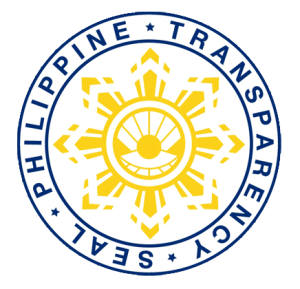
In National Budget Circular No. 542, issued on August 29, 2012, the Department of Budget and Management (DBM) reiterates compliance by all offices of the national government, including state universities and colleges, government-owned and controlled corporations, government financial institutions and local government units with Section 93, the Transparency Seal provision, of Republic Act (R.A.) No. 10155, also known as the General Appropriations Act of 2012, to wit:
“Sec. 93. Transparency Seal. To enhance transparency and enforce accountability, all national government agencies shall maintain a transparency seal on their official websites. The transparency seal shall contain the following information: (i) the agency’s mandates and functions, names of its officials with their position and designation, and contact information; (ii) annual reports, as required under National Budget Circular Nos. 507 and 507-A dated January 31, 2007 and June 12, 2007, respectively, for the last three (3) years; (iii) their respective approved budgets and corresponding targets immediately upon approval of this Act; (iv) major programs and projects categorized in accordance with the five key results areas under E.O. No. 43, s. 2011; (v) the program/projects beneficiaries as identified in the applicable special provisions; (vi) status of implementation and program/project evaluation and/or assessment reports; and (vii) annual procurement plan, contracts awarded and the name of contractors/suppliers/consultants.”
The Circular also declares that the respective heads of the agencies shall be responsible for ensuring compliance with this section.
The Circular directs that the Transparency Seal must be prominently displayed on the main page of the agency website, and linked to a page within the agency website that contains the aforementioned documents in downloadable format.
Symbolism of the Transparency Seal
A pearl that is buried inside a tightly-shut shell is practically worthless. Government information is a pearl, meant to be shared with the public in order to maximize its inherent value.
The Transparency Seal, depicted by a pearl shining out of an open shell, is a symbol of a policy shift towards openness in access to government information. On the one hand, it hopes to inspire Filipinos in the civil service to be more open to citizen engagement; on the other, it seeks to invite the Filipino citizenry to exercise their right to participate in governance.
This initiative is envisioned as a step in the right direction towards solidifying the position of the Philippines as the Pearl of the Orient – a shining example for democratic virtue in the region.
The Local Government Unit of San Carlos City compliance with Transparency Seal (per Annex 10 of DBM Memo Circular No. 2015-1 dated August 10, 2015)
The City
CHAPTER 1 – ROLE AND CREATION OF THE CITY
SEC. 448. Role of the City. – The city, consisting of more urbanized and developed barangays, serves as a general-purpose government for the coordination and delivery of basic, regular, and direct services and effective governance of the inhabitants within its territorial jurisdiction. -RA 7160 (LGC, 1991)
LGU Vision
“A modern agro-industrial processing city, a model green city on good governance, a renewable energy hub for Asia, and a sustainable tourism destination with strong, diverse and viable economy, and an ecologically balanced and sustainable environment with functional, appropriate and accessible infrastructure where citizens are healthy and well educated, living in a harmonious and peaceful community, under a dynamic, competent, and reliable leadership in a safe, adaptive and resilient city.”
LGU Mission
“ To achieve food self-sufficiency and security, resource-based diversification and balanced agro-industrial and tourism opportunities with educated, healthy and empowered citizenry in a livable, resilient community, providing opportunities for economic development through sustainable renewable energy investments complemented with efficient and effective delivery of basic socio-economic services with infrastructure support, and strong public-private partnership for suitable and environmentally friendly development programs under a dynamic leadership.”
Performance Pledge
We, the San Carlos City government officials and employees, commit ourselves to ensure the best delivery of all frontline services that each department within the Local Government Unit must provide to the city’s constituents. We shall faithfully discharge our duties and functions with efficiency, courtesy, honesty and promptness because…
Service is the reason of our existence.
Philosophy of Service
ACCOUNTABILITY – We believe that public service is a public trust and therefore we shall be held liable for our conduct in the service and responsibly for the trust accorded to us by the people.
COURTESY – We give due respect to the dignity of each individual and his inherent rights and privileges with due recognition that they provide the funds for our subsistence.
EXTRA-MILE WORK ATTITUDE – We believe in working more than the hours for which we are paid for in the interest of better public service.
FAIRNESS – We believe that men are created equal in the eyes of God and they all deserve the same special treatment no matter what status or standing in life
ECONOMY- We believe in spending the people’s money wisely in keeping with the trust that they bestowed upon us in serving their needs
PROMPTNESS – We believe that time is of the essence and any late delivery of services will result to opportunity loss for the people we serve
EXCELLENCE – We believe in giving the best performance as a reflection of our own noble desire for the highest standard of service.
PROFESSIONALISM – We believe that better service are best delivered when the human resource is technically capable and knowledgeable of the right and updated ways of doing things.
CLIENT-ORIENTED SERVICE – We know by heart that whatever work we do will redound to the benefit of the public and therefre their interest shall be the ultimate goal of our performance.
